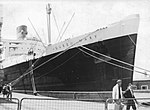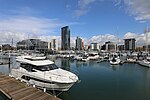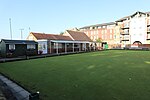National Oceanography Centre
The National Oceanography Centre (NOC) is a marine science research and technology institution based on two sites in Southampton and Liverpool, United Kingdom. It is the UK’s largest institution for integrated sea level science, coastal and deep ocean research and technology development.From 1 November 2019 the NOC began operating as an independent self-governing organisation – a charitable company limited by guarantee. The centre was set up to work in close partnership with institutions across the UK marine science community to address key science challenges, including sea level change, the oceans’ role in climate change, predicting and simulating the behaviour of the oceans through computer modelling, the future of the Arctic Ocean and long-term monitoring technologies.
Excerpt from the Wikipedia article National Oceanography Centre (License: CC BY-SA 3.0, Authors).National Oceanography Centre
Tasman Close, Southampton Ocean Village
Geographical coordinates (GPS) Address Nearby Places Show on map
Geographical coordinates (GPS)
| Latitude | Longitude |
|---|---|
| N 50.89286 ° | E -1.39481 ° |
Address
Waterfront Campus
Tasman Close
SO14 3TP Southampton, Ocean Village
England, United Kingdom
Open on Google Maps









